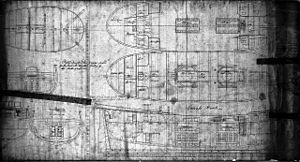HMS Carcass (1759) facts for kids

View of the Racehorse and Carcass 7 August 1773, when inclosed in the ice in Lat. 80° 37′ N.
|
|
Quick facts for kids History |
|
|---|---|
| Name | HMS Carcass |
| Ordered | 21 September 1758 |
| Builder | Stanton & Wells, Rotherhithe |
| Laid down | 28 September 1758 |
| Launched | 27 January 1759 |
| Commissioned | 27 June 1759 |
| Fate | Sold on 5 August 1784 |
| General characteristics | |
| Class and type | Infernal-class bomb vessel |
| Tons burthen | 309 |
| Length |
|
| Beam | 28 ft (8.5 m) |
| Draught |
|
| Depth of hold | 12 ft 1 in (3.68 m) |
| Propulsion | Sails |
| Sail plan | Full-rigged ship |
| Complement | 60 (110 as sloop) |
| Armament |
|
HMS Carcass was a special kind of ship called a Infernal-class bomb vessel in the Royal Navy. These ships were built to carry powerful cannons called mortars. Later, Carcass was changed into a survey vessel, which means it was used to explore and map areas.
A very famous person, Horatio Nelson, served on Carcass when he was a young midshipman. He joined the ship for an exciting trip to the Arctic in 1773.
Contents
Building a Bomb Vessel: HMS Carcass
The Infernal class ships, like Carcass, were designed by a person named Thomas Slade. Carcass was ordered on September 21, 1758. It was built at Stanton & Wells in Rotherhithe, a place in London.
The ship was launched into the water on January 27, 1759. This means it was ready to float! It was officially named Carcass a week before its launch. On June 27, 1759, Carcass became a sloop at Deptford Dockyard.
Adventures and Expeditions
Carcass had many adventures during its time. Its first commander was Charles Inglis. He took the ship to join Admiral George Rodney's group of ships in the English Channel.
In July 1759, Carcass was part of an attack on Le Havre, a city in France. The next year, it captured a French ship called Mercury. Carcass was repaired and updated several times over the years.
Arctic Exploration with Young Nelson
In 1773, Carcass was prepared for a very special trip. It was going on an expedition to the Arctic, the cold region around the North Pole. This trip cost a lot of money to get the ship ready.
Carcass joined Constantine Phipps's expedition. This is where young Horatio Nelson came aboard as a midshipman. His uncle, Maurice Suckling, helped him get this position.
The ships sailed very far north, getting close to the North Pole. However, thick ice blocked their way, and they had to turn back. They returned to Britain in September 1773.
A story later spread about Nelson during this trip. While the ship was stuck in the ice, Nelson supposedly saw a polar bear and chased after it. When asked why, he said he wanted the bear's skin for his father. This story shows how brave and determined Nelson was, even as a young boy.
Later Service and Sale
After the Arctic trip, Carcass continued its service. In 1775, it sailed to the coast of Africa. Later, in May 1776, it went to North America.
The ship served under several commanders. In 1780, it sailed to the West Indies. By the end of 1780, it was near the Leeward Islands.
Finally, Carcass was taken out of service in December 1781. It was sold for £320 on August 5, 1784.
See also
- European and American voyages of scientific exploration


